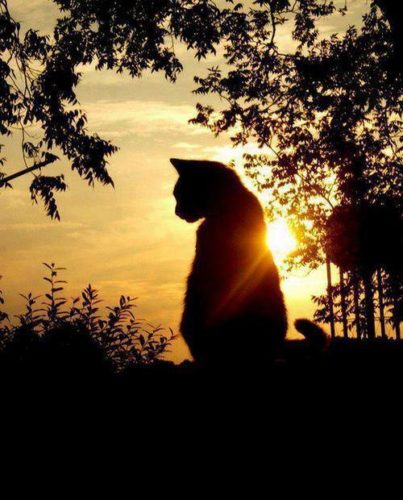 Today is Black Cat Appreciation Day. Started by Wayne Morris in 2011 as a way to honor his deceased sister and the bond she shared with her beloved black cat, Sinbad, as well as to pay tribute to black cats in general, the celebration caught on quickly and is now widely observed. Wayne’s “Black Cat Appreciation Page” boasts over 278,600 fans and is growing daily (go, like, share!).
Today is Black Cat Appreciation Day. Started by Wayne Morris in 2011 as a way to honor his deceased sister and the bond she shared with her beloved black cat, Sinbad, as well as to pay tribute to black cats in general, the celebration caught on quickly and is now widely observed. Wayne’s “Black Cat Appreciation Page” boasts over 278,600 fans and is growing daily (go, like, share!).
Although thought to be good luck in many cultures, black cats are not regarded as lucky in America, and black cats (and dogs) often languish in shelters for weeks before they are adopted; if they are adopted. Shelters all across the states hope that by dedicating a day to highlight black kitties and their plight, adoption rates will go up.
Rather than listing and debunking all the silly myths that have grown up around our ebony feline friends, here are some fascinating facts instead.
Black cats get their color from melanism, a color mutation caused by the abundance of a dark-colored pigment called melanin. Melanism is the opposite of albinism, and scientists believe is has surfaced independently several times in the cat family. So far, it has been documented in 11 of the 36 wild cat species, and “black panthers” are actually melanistic jaguars, leopards or jaguarondis.
Some cats are a lovely pure obsidian, but others are tabbies in disguise. Put these cats in bright sunlight and you might see ghostly tabby stripes on the tail or legs, or the classic “M” pattern on the head. Bright sunlight will also reveal spots on a black jaguar and rosettes on a black leopard. If you can get close enough, that is!
In addition to raven fur, high levels of melanin in the pigment of cats produces beautiful yellow irises, so black cats often have gorgeous copper eyes.
Sable-colored kitties can be male or female, but there are more of the former.
Solid black is a recognized color option in 22 cat breeds registered by the US-based Cat Fanciers’ Association. The beautiful and intelligent Bombay, however, is the only cat that is always black. Here’s a short but informative video on these elegant felines…
Cats101: The Bombay
Melanin production is dependent upon tyrosine, an amino acid that is conditionally essential for cats (although nonessential for other species), and tyrosine deficiency commonly results in the fur of black cats turning reddish-brown. The effect can be reversed by feeding these cats diets that contain increased concentrations of tyrosine, such as those high in animal-sourced proteins.
Interestingly, recent research by the National Institutes of Health indicates that black cats may be more resistant to pathogens and illnesses such as feline immunodeficiency virus (FIV). This has fascinating implications for the treatment of both FIV and HIV.
Black cats are as graceful and amazing, as loving, mischievous and varied in their personalities as any other cat. And they deserve happy forever homes! In honor of Black Cat Appreciation Day, go visit your local animal shelter and add a coal-colored kitty to your family today!
And if your home is or has ever been graced by the soft sooty paws of a black cat, please share their stories in the comments below, or pop over to CatCentric’s Facebook page, post their pics and tell us why each one is special to you!

